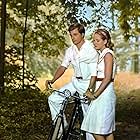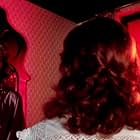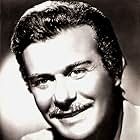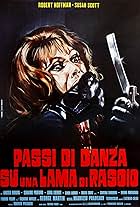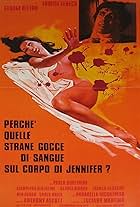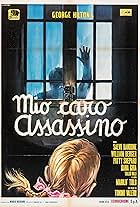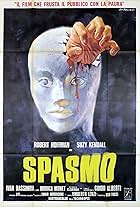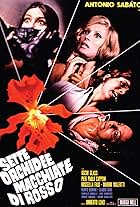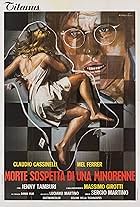IMDb RATING
6.3/10
2.1K
YOUR RATING
The body of a schoolgirl is found in a meadow. The murderer is never caught, and years later, a young man named Stefano returns to the island and is reunited with his brother, the local prie... Read allThe body of a schoolgirl is found in a meadow. The murderer is never caught, and years later, a young man named Stefano returns to the island and is reunited with his brother, the local priest.The body of a schoolgirl is found in a meadow. The murderer is never caught, and years later, a young man named Stefano returns to the island and is reunited with his brother, the local priest.
Craig Hill
- Don Paolo
- (as Graig Hill)
Alina De Simone
- Medium
- (as Alina Simoni)
Sonia Viviani
- Girl walking with Signora Nardi
- (as Sonia Vivani)
Fortunato Arena
- Antonio, Innkeeper
- (uncredited)
Antonio Bido
- Man at cemetary
- (uncredited)
Eolo Capritti
- Customer in restaurant
- (uncredited)
Storyline
Did you know
- TriviaAntonio Bido: Man at cemetery.
- GoofsWhen the killer is being revealed and the main character pulls out the newspaper article, you can see and hear a flash from camera, probably taking pictures of the scene.
- ConnectionsFeatured in Solamente Bido (2002)
Featured review
Directed by Antonio Bido, this is by far his best film of his career (Though, admittedly, his only other film of any note is the 1977 Giallo "Watch Me When I Kill").
The film's narrative is relatively typical of a giallo: Someone is killing people in a small village and a priest tries to unravel the mystery of the killer's identity. What's atypical is the film's tone. The film is noteworthy for being one of the more serious and mature of the giallo genre. Bido avoids the giallo's often sleazy nature and embraces the Gothic and religious aspects instead.
Another interesting point is how the film focuses on two main protagonists, the priest and his brother, and how they collaborate with one another to discover the killer. Interesting narrative method having two focal points rather than one, not original but unconventional.
The performances are generally good with Craig Hill as giving an impressive performance as the priest. He exhibits a broad range of emotions from anger to sorrow, from determination to helplessness, and makes it totally convincing.
The cinematography is main feature of the film because it is its strongest trait. The visuals portray a wet and muggy Italy, with fog and mist enveloping the landscapes and rain falling, creating pools of water. This all builds a gloomy and foreboding atmosphere that conveys feelings of isolation, loneliness, dread, anguish, and death.
The characters are generally good as well, each with a strong history and believable relationships between one another. The greatest of which is the relationship between the priest and his brother, which is totally believable because not only of both of their performances, but also the development of their characters.
And lastly, the film features some wonderful aesthetic qualities through it's use of editing. Bido inter splices Catholic and Religious imagery to make comments about the characters and the religious institution as a whole.
The film has a few problematic issues. First of all, the narrative isn't clearly focused. The film appears to be more concerned with the visuals and the individual, isolated events in the film rather than the mystery as a whole. Thus, this damages the film's impact as it approaches the end, because here the mystery plays center stage but is underdeveloped.
The narrative also suffers from several of the genre's conventions and clichés, thus leading to a sort of predictability of the story. The film features the typical gloved killer, the extended stalking sequences leading to a gruesome death, the multiple red herrings, childhood traumas, and a host of other archetypes of the giallo.
Also, the final revelation stretches plausibility and thus may become unacceptable to some viewers, especially when one recalls the events that have transpired throughout the film.
Never the less, this is one of the better giallos out there.
Recommended to those who enjoy the mystery/thriller genre, though it is not essential unless you are a fan of the giallo genre. For the casual film viewer, there are better examples of the giallo genre and thus would recommend that you skip this and view one of the apexes of the genre such as Suspiria.
The film's narrative is relatively typical of a giallo: Someone is killing people in a small village and a priest tries to unravel the mystery of the killer's identity. What's atypical is the film's tone. The film is noteworthy for being one of the more serious and mature of the giallo genre. Bido avoids the giallo's often sleazy nature and embraces the Gothic and religious aspects instead.
Another interesting point is how the film focuses on two main protagonists, the priest and his brother, and how they collaborate with one another to discover the killer. Interesting narrative method having two focal points rather than one, not original but unconventional.
The performances are generally good with Craig Hill as giving an impressive performance as the priest. He exhibits a broad range of emotions from anger to sorrow, from determination to helplessness, and makes it totally convincing.
The cinematography is main feature of the film because it is its strongest trait. The visuals portray a wet and muggy Italy, with fog and mist enveloping the landscapes and rain falling, creating pools of water. This all builds a gloomy and foreboding atmosphere that conveys feelings of isolation, loneliness, dread, anguish, and death.
The characters are generally good as well, each with a strong history and believable relationships between one another. The greatest of which is the relationship between the priest and his brother, which is totally believable because not only of both of their performances, but also the development of their characters.
And lastly, the film features some wonderful aesthetic qualities through it's use of editing. Bido inter splices Catholic and Religious imagery to make comments about the characters and the religious institution as a whole.
The film has a few problematic issues. First of all, the narrative isn't clearly focused. The film appears to be more concerned with the visuals and the individual, isolated events in the film rather than the mystery as a whole. Thus, this damages the film's impact as it approaches the end, because here the mystery plays center stage but is underdeveloped.
The narrative also suffers from several of the genre's conventions and clichés, thus leading to a sort of predictability of the story. The film features the typical gloved killer, the extended stalking sequences leading to a gruesome death, the multiple red herrings, childhood traumas, and a host of other archetypes of the giallo.
Also, the final revelation stretches plausibility and thus may become unacceptable to some viewers, especially when one recalls the events that have transpired throughout the film.
Never the less, this is one of the better giallos out there.
Recommended to those who enjoy the mystery/thriller genre, though it is not essential unless you are a fan of the giallo genre. For the casual film viewer, there are better examples of the giallo genre and thus would recommend that you skip this and view one of the apexes of the genre such as Suspiria.
- Schwenkstar
- Feb 27, 2006
- Permalink
- How long is The Bloodstained Shadow?Powered by Alexa
Details
- Runtime1 hour 49 minutes
- Sound mix
- Aspect ratio
- 1.85 : 1
Contribute to this page
Suggest an edit or add missing content

Top Gap
By what name was The Bloodstained Shadow (1978) officially released in India in English?
Answer






